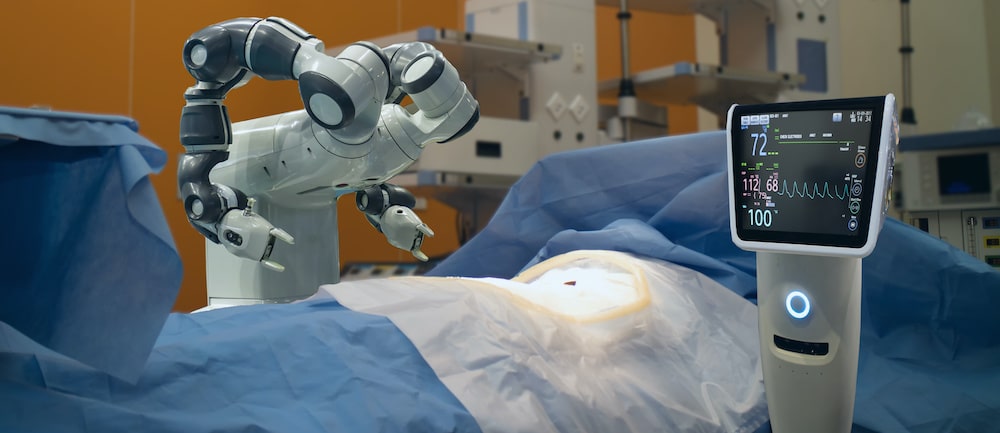
As we navigate the daunting challenges of pivoting our current healthcare system to better treat and contain the spread of COVID-19 and future pandemics, artificial intelligence has taken center stage. The potential of AI for healthcare transformation is vast and all-encompassing –– it can improve the quality of patient care, streamline hospital processes, reduce bias, accelerate detection, and prevent disease.
In our first-ever virtual conference titled, “AI for Healthcare in the Time of COVID-19,” we gathered thought leaders from technology companies and healthcare organizations to discuss how AI is helping to stem the tide of COVID-19 cases and explore the practical applications of this technology in the healthcare space.
Here are some of the top insights about AI’s help in the response to COVID-19 and what AI can bring to the medical field’s understanding, diagnosis, and treatment of disease.
1. AI Will Make Smart Hospitals Part of the Care Team And Improve Doctor-Patient Relations
In “What’s on the Cutting Edge of AI” Mattew Versaggi described the benefits of smart hospitals and how they can become so smart that they effectively become part of a patient’s care team. AI will be able to move objects around in the environment based on patient and doctor preferences, optimize flows, and better assess the hospital’s inventory of materials.
Optimizing the hospital infrastructure with digital systems that can monitor, sense, and learn how to best heal patients at the individual level while also delivering high-quality care economically is going to be a game-changer.
“Electronic medical records that can pull in data from a variety of sources instantly will help physicians practice at the top of their license, eliminating precious time spent on data entry,” Versaggi said. Intelligent assistants are a huge component of how AI for healthcare can help streamline the EMR input process and allow for data collection to occur at a faster and more efficient rate.
Dr. Eric Topol, a world-renowned cardiologist, also discussed this point with Sebastian Thrun in the keynote presentation. “The biggest complaint about doctors and from doctors is the keyboard,” Topol said. That can be liberated today if we get behind the AI frontier and shift our focus to the conversation between the doctor and patient.
Eliminating this barrier during the doctor-patient interaction can create space for the patient to trust that the doctor will listen, guide them, and care about them. “That can be more important than the treatment,” Dr. Topol said.
“If we can get rid of mundane things that can be diagnosed by a patient or by their parents then we can get to the serious matter––bringing the doctor and patient together.”
2. AI Will Improve Clinical Decision Making and Support Doctors
“How AI Improves Clinical Decision Making” kicked off with Dr. Rutledge, Chief Medical Officer and Co-Founder at HealthTap, discussing the importance of integrating data-driven models with knowledge-driven components from doctors to help make successful clinical decisions.
He explained that the academic perspective taught in medical schools isn’t always reliable in determining the best clinical decision. With AI for healthcare, it’s possible to build a consensus-driven model from hundreds of thousands of different doctors that reduce individual bias.
Integrating data-driven models with the consensus-driven component from experienced doctors will allow these systems to quickly assess the best course of action. The current challenge is obtaining sufficient data so these systems can understand the complexities of patient symptoms and correctly classify them as well as doctors do.
We’ve already seen success with this in AI’s ability to classify medical images, like with x-rays and retinal scans. AI will improve and quicken diagnosis on the clinical level as well. It is possible to have clinically-driven prediction models supporting doctors at the point of care, giving doctors diagnostic support in real-time.
3. Better Data and a Review Framework Will Help Remove Bias
The main reason we’ve seen racial bias emerge in widely-used healthcare algorithms is because of skewed or incomplete data. “To combat this, we need to access all the information, especially the right information,” Jochen Kumm said in the “Ethics in AI” panel. “We also need to ask ourselves: What is the marker we actually want to train on? What are we trying to achieve?” Kumm stressed.
Ultimately bias is a pattern, and AI finds patterns. Bias is everywhere –– it’s in the data, in the way we build algorithms, it can even come from data scientists. One way to bypass this is by implementing an escalation path.
Data scientists can quickly engage a diverse group of people to discuss where and what bias might be at play in a certain application. AI for healthcare could greatly benefit from a framework or review agency that keeps bias in check.
Tiffany Deng detailed how COVID-19 has revealed the disproportionate survival rate of the disease for different communities. There are so many factors that make minority groups more susceptible to contracting this disease. “We’ve been given an opportunity to examine the data and see the importance of building social foundations to ensure that outcomes are more equitable and that all people have access to proper healthcare and education,” Deng said.
4. Early Detection Requires Well-Curated Data Sets
In “Deciphering the Data of COVID-19” the panel stressed that prioritizing the release of high-quality, curated, and labeled data will allow us to predict future pandemics.
Dr. Matt Lungren, co-director at Stanford AIMI, gave an example of an imaging challenge they investigated last year. They used CT to detect bleeding in the brain with AI. “We received over 22,000 individual models, the top 10 of which performed better than a lot of the FDA-cleared solutions for the same problem,” said Dr. Lungren.
Creating well-curated data sets around a clinical problem, and engaging with the community at large, provides a variety of solutions that enables doctors and scientists to move the field forward with new ideas.
We’ve seen a similar occurrence with COVID-19 when scientists published the unique viral genome. By making the entire genome available to the scientific community, individual scientists were able to build vaccines and test solutions. “Because they released the source, we can all apply our own science, our own technologies, our own approaches, and actually come up probably with a better idea in the long run,” Dr. Lungren said.
In terms of implementation, AI for healthcare along with background screening of asymptomatic individuals could potentially flag a high-risk patient. As 40% of people infected with COVID-19 are asymptomatic, if a patient is imaged for an unrelated health concern and doctors can identify COVID-19, we’ll be in a much better position.
5. Wearable Devices: The Key to Saving Lives
In addition to identifying COVID-19 by viral detection and antibody response, we can also suspect viral infection indirectly through resting heart rate. Dr. Eric Topol explained in the “AI for Healthcare Keynote” that for a flu-like illness, the resting heart rate marker allows us to predict illness throughout the country from a wearable device like a Fitbit or Apple watch.
Dr. Topol states that heart rate rises before a fever is present, so even if someone doesn’t get a fever or experience symptoms, we can still detect that their body is fighting a virus. “Resting heart rate, with the analytics of AI for healthcare, can predict where an outbreak is likely to happen and that’s a topic that doesn’t get enough respect because people just think test, test, test and they don’t understand that digital surveillance with AI can be very useful,” said Dr. Topol.
Pulse oximetry in wearable devices can also help us detect the virus’s damage to the lungs. Dr. Topol thinks that the way to get ahead of this virus is simple: equip everyone with a wearable device that has a pulse oximeter and collects resting heart rate and body temperature. “Here we are in the US spending trillions of dollars. What we should be thinking about is: what can we arm each person with, so that we can help protect them?” Dr. Topol said.
The simple collection of accurate biometric data in real-time effectively gives power back to the patient, which is exactly where it should be. A smartphone ultrasound can be in everyone’s home and produce high-resolution data on almost every organ in seconds.
Sebastian Thrun pointed out that, “The current medical model of diagnosis is based on symptoms, going to the doctor, and getting lab work. For diagnosing cancer, stroke, and congestive heart failure, this is often too late.” If we can get a diagnosis to precede pain and the doctor’s visit, we can treat the early stages of these diseases, which are usually very treatable early on.
Dr. Topol explained that it’s possible to use a blood test for detecting cancer with Machine Learning analysis to make a diagnosis before anyone would know it. “We can issue blood tests for a specific gene and test every six months for an at-risk patient and they’ll never get advanced cancer,” he said. Given the number of deaths that cancer takes every year, this is nothing short of life-changing.
There’s no doubt that AI for healthcare is transforming the medical field’s understanding of disease and its ability to treat, cure, and prevent the transmission of diseases on a large scale. There are a variety of high-stake questions surrounding data privacy, trust for the healthcare system, as well as shifting the power dynamic by giving patients the ability to screen for certain diseases themselves at home.
No matter your opinion, it’s clear that AI holds the key to revolutionizing health at every touchpoint.
If any of these discussions sparked your interest, enroll in the AI for Healthcare Nanodegree program and join us at the forefront of this fascinating intersection of medicine and AI.







